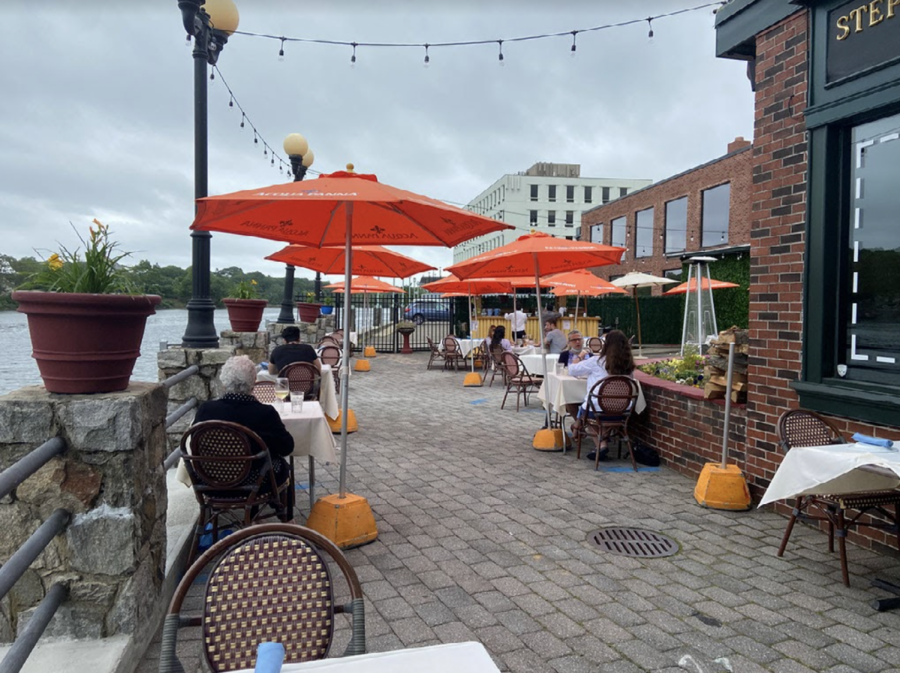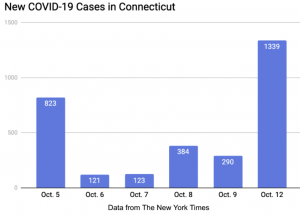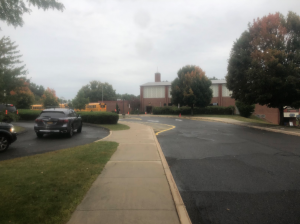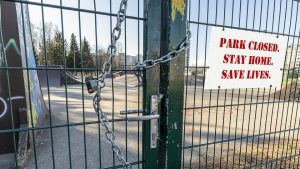Phase 3 of reopenings launched as COVID-19 rates increase among youth
With the new Connecticut Phase Three plan in place, Arezzo restaurant-goers are now free to eat outside with no maximum capacity and inside up to 75% capacity.
Phase 3 of statewide reopening amid the COVID-19 pandemic was implemented on Oct. 8 as the next step in the four-phase plan for reopening designed by Governor Lamont and his administration.
The new, more lenient protocols include an increase from 50% to 75% capacity for indoor seating at restaurants, personal services, hair salons, barber shops and libraries; an increase from 25% to 50% capacity at outdoor event venues and an opening of indoor performing arts venues at 50% capacity with mask and social distancing requirements; 50% capacity with a cap at 100 people instead of the former 25 for indoor gatherings at commercial establishments or places of business; and a cap at 150 people instead of the previous 100 for private outdoor gatherings, according to Lamont’s Sept. 24 press release.
“I think [Phase 3] is very ambitious, but I am very optimistic,” Eva Fitch ’21 said. “We’re so far into the pandemic and there needs to be some form of forward thinking at this point, so I think in order to progress and maneuver our way through this pandemic there have to be big steps taken like these.”
Additionally, graduations are now allowed indoors at 50% capacity capped at 200 people, and outdoors at 50% capacity with no cap. Indoor religious services may now operate at 50% capacity capped at 200 and outdoor religious services may also operate at 50% capacity but with no cap whatsoever. Masks and social distancing are still required for both indoor and outdoor graduations and services.
The reopening protocols were developed by Governor Lamont, members of his office and the Department of Economic and Community Development, in coordination with state legislators and the Reopen Connecticut Advisory Group, which consists of medical experts and representatives of several businesses and industry groups.
According to state representative Jonathan Steinberg, the prominent role of the executive office over the Connecticut legislature is not uncommon for COVID-19 related measures, most of which were accomplished through executive orders.
“It’s a strange feeling for [us] legislators, but we’ve intentionally ceded our piece of the driver’s seat to the Governor during the pandemic,” Steinberg said. “These emergency powers are deemed necessary to provide the flexibility and agility to quickly respond to problems in real time — something that the legislative process can’t provide.”
Despite the diminished role of the legislative branch, Steinberg and other representatives remain involved in coronavirus-related decisions, holding several weekly meetings on the topic as part of a new COVID-19 working group created by Lamont.
“The Administration has heeded our demands to be engaged in the decisions,” Steinberg said. “It may not be exactly ‘advise and consent,’ but we’re playing an appropriate role, all things considered.”
While some commend the state government for their bold steps towards reopening, others remain skeptical and fear that Phase 3 is too drastic of a step at a time when such change is not yet warranted.
“There’s not even a vaccine yet,” Lili Aldridge ’22 said. “There’s no cure, we’re still just playing it by ear. I wouldn’t want us going into Phase 3 until we see a plateau in numbers or at least a slight decrease.”
Despite understanding the urgent need to ease the harsh conditions for businesses and families, Steinberg shares Aldridge’s concern about enacting Phase 3 so soon, and fears that if Phase 3 causes another spike in cases, it would be difficult to reverse the trend and bring the state back into quarantine.
“The timing, to me, is problematic,” Steinberg said. “It’s fall, it’s flu season, many kids are in school — all factors more likely to lead to higher infection rates […] People are getting lax and frustrated, and will soon be spending most of their time indoors. Are we asking for trouble by increasing density of activity at this moment?”
This more cautious viewpoint is not unique to Steinberg, but is typical of most Democrats in the Connecticut legislature. Most conservatives in Congress favor a faster-paced reopening and are more averse to ceding power to the executive branch.
“There is some partisan divide,” Steinberg said. “But I’m inclined to focus on the remarkable collaboration I’ve observed with my colleagues as we’ve all striven to do the right thing. Our commitment to the people of the state supersedes ideology.”
According to First Selectman Jim Marpe, when Lamont first issued the reopening guidelines, the original Phase 3 plan differed drastically from the current one. It had initially planned to increase the number of attendees at indoor gatherings and open more establishments where people may congregate, whereas now, it only increases the capacity permitted at outdoor gatherings and indoor gatherings at places of worship and restaurants.
“I feel that the Governor’s decision to move the state into Phase 3 is warranted given the current low infection rates in Connecticut,” Marpe said. “I think that this version of Phase III is appropriate for the State at this time because it is based both in what science has revealed to us over the last several months, and on what the public has proven capable of complying with. We have all heard and expressed concerns for another potential spread during the fall months and in my opinion, the current plan laid out by the Governor is smart.”
The Reopen Westport Advisory Team will continue to work with local businesses, places of worship and nonprofits to execute Phase 3 while keeping employees and clients safe. It also plans to help restaurants design outdoor dinings spaces that they can remain usable throughout the winter.
Fitch hopes that outdoor dining will remain an option as we go into the winter, as she personally feels safer eating outside for the time being.
“When I go out to eat, which isn’t very often, I do like to take advantage of the outdoor seating,” Fitch said. “Especially with the 75% capacity, I think that is a little bit risky, since restaurants haven’t been open for that long..”
On the other hand, some students like Aldridge are less concerned and dine out often with their families at both indoor and outdoor locations.
“I think that restaurants are trying so hard to meet COVID cleaning requirements and being safe and being very wary of having everything be in tip-top-shape,” Aldridge said. “But people will still be dining outside. People are still going to be scared, so even if they say 75% capacity, I think it’ll still stay at [50% occupancy].”
Marpe stresses the effectiveness of the precautions restaurants and businesses have undertaken, as none of the mini-outbreaks of COVID-19 that occured in Westport had been traced back to a commercial establishment.
“Our local business community has been very diligent in managing these reopening phases,” Marpe said. “I am grateful that they have worked with the town, and that they clearly have the best interests of […] the community, in the forefront during this difficult period.”
Even as Connecticut enters a new phase of reopening, statewide COVID-19 cases continue to escalate, especially among the younger population. As of Oct. 2, over 40 school districts in Connecticut have had one or more schools shut down since their reopening, according to the Hartford Courant.
“I think we as a school community have done well, but we can’t control what happens outside these walls,” Staples nurse Anna Fitzpatrick said. “Large social gatherings are usually super-spreader events, so I think people should continue to maintain good habits […] if we want to control this. The goal is to stay in school, so that means everybody has to do their part.”
Emily Epstein ’22 believes that the recent increase in COVID rates among the youth stems not from school reopenings, but rather from large social gatherings that continue to be held, especially those bringing together students and families from different towns.
“People are having bat mitzvahs and bar mitzvahs,” Epstein said. “I think these events increase [young] people getting the virus because they would be around people from other areas. Also, a lot of colleges, boarding schools, stuff like that also is probably a reason for the increase in the younger population getting COVID because again, people from other places are all coming together.”
In light of the recent uptick in COVID-19 cases among Connecticut youth, some students feel disconcerted with the fact that the state has continued its reopening plan despite the spike.
“It’s crazy how they just say ‘oh, now you can do all this stuff,’” Grace Horton ’22 said. “I mean cases aren’t really decreasing, so I’m just kind of like ‘bruh’ […] how does it just magically work that one day we just get Phase 3?”
Due to the false assurance that Phase 3 reopenings may provide, Fitzpatrick is concerned about their potential to cause a proliferation in social gatherings among students and, subsequently, an even more dramatic spike in COVID-19 cases among youth.
“Just because the governor is going to open things up doesn’t mean people can just throw caution to the wind,” Fitzpatrick said. “I think that’s the key, you just can’t really let your guard down no matter what the laws say. The virus doesn’t understand the law, and especially with flu season coming it’s still very important to maintain good habits.”
As temperatures grow colder and people spend more time indoors, Marpe seeks to remind residents that the shift to Phase 3 does not mean the pandemic is coming to an end, and that it’s essential for Westporters to employ safety precautions.
“I would like to remind your readers that they are not immune to COVID-19,” Marpe said. “It is incumbent upon all age groups to do their part to stop the spread— wear a mask, social distance and limit exposure to others to allow for easier contact tracing. Westport can proceed with the State’s plans for Phase 3, but I continue to stress that if we want to stay open, we all need to remain cautious, vigilant and alert.”

Editor-in-Chief Natalie Bandura '22 shares an interest for political science and the STEM fields.
From a Fall 2020 internship with Senator Will Haskell...




















































